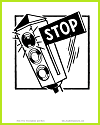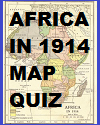| Dashed Arrow Classroom PDF Sign |
|---|
| www.studenthandouts.com ↣ Classroom Organization ↣ Classroom Signs |
 |
|
Dashed Downward Arrow Sign - Free printable. Click here to print. Arrows are iconic sign markers for several reasons. Simplicity: Arrows are simple geometric shapes, typically consisting of a straight line with a triangular or pointed end. This simplicity makes them easy to understand and recognize, even from a distance. Directional Clarity: Arrows are primarily associated with indicating direction. A single arrow can convey a clear message about which way to go, making them a universally understood symbol for navigation and guidance. Universal Symbolism: Arrows have been used as symbols throughout history and across cultures to represent concepts like movement, progress, and direction. This universality contributes to their iconic status. Visual Contrast: Arrows often have a distinct appearance compared to other symbols or shapes. Their sharp, pointed ends and linear design create visual contrast, helping them stand out on signs and in various contexts. Versatility: Arrows are highly versatile and can be used in various applications. They can point up, down, left, right, or diagonally, and they can be combined to create more complex directional instructions. Intuitive communication: Arrows intuitively convey a sense of movement or progression. When people see an arrow, they naturally associate it with the idea of going in a particular direction or following a path. Economical Design: Arrows are often economical in terms of space and design. They can convey information concisely, which is important for signage and wayfinding where space may be limited. Attention Grabber: Due to their simplicity and the contrast they create, arrows tend to catch the viewer's attention quickly. This makes them effective for guiding people's focus or indicating important information. Consistency in Road Signs: Arrows are prominently used in road signs to guide drivers and pedestrians. Over time, people have become accustomed to recognizing and obeying directional arrows on the road. Cultural and Historical Associations: Arrows have cultural and historical significance in various contexts, such as archery, Native American symbolism, and ancient Greek mythology. These associations can add depth to their meaning. Digital Age Relevance: In the digital age, arrows are commonly used in user interfaces and icons to signify actions like scrolling, clicking, or navigating within software and apps. This reinforces their contemporary relevance. Emergency Signage: Arrows are often used on emergency exit signs to indicate the direction of escape routes. This use is critical for safety and evacuation procedures. Environmental Friendliness: Arrows are often used on recycling bins and eco-friendly products to symbolize sustainability and responsible consumption. In summary, arrows have become iconic sign markers due to their simplicity, clarity, versatility, and universal symbolism. They effectively convey directional information, guide people, and draw attention, making them a widely recognized and timeless symbol in various contexts, from road signs to user interfaces. |
 |  |  |  |  |  |
| www.studenthandouts.com ↣ Classroom Organization ↣ Classroom Signs |








